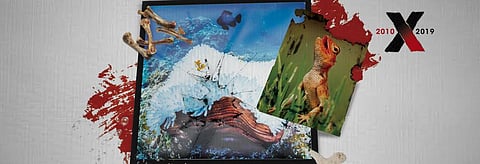

“Nature is declining globally at rates unprecedented in human history — and the rate of species extinctions is accelerating with grave impacts on people around the world now likely,” says the first-ever Global Assessment Report on Biodiversity and Ecosystem Services by Intergovernmental Science-Policy Platform on Biodiversity and Ecosystem Services.
According to the assessment, one million animal and plant species are under extinction. Thousands of these would get extinct within decades. Three-quarters of the land-based environment and two-thirds of the marine environment have been significantly altered by human actions. The decade also marked the formal declaration of the Anthropocene, or the age of the humans. Here's how DTE covered the issue in October 2012:
All is not well
Persistent pollution from chemicals, overfishing — 80 per cent of fish stocks are said to be fully or overexploited — and higher levels of carbon dioxide in the atmosphere have degraded coastal and marine biodiversity to unprecedented levels, threatening the livelihoods of 500 million people who depend on the seas and the health of over a billion people who get their main source of protein from the oceans and seas. This vast expanse of blue also harbours ecosystems such as coral reefs that nourish as much life as our richest rainforests.
But it’s not as if the world does not understand the importance of biodiversity for human well-being. The Convention on Biological Diversity (CBD), which grew out of the epochal Rio Earth Summit of 1992, was established as a legally binding pact to arrest a precipitous decline in biodiversity. CBD brings together 193 signatories or Parties as they are called (192 nations and the European Union) and in 2002 it undertook to “significantly reduce” biodiversity loss in a decade.
However, a 2010 review tracking progress on this target showed the deterioration was accelerating. The study published in Science in May 2010 reported that most indicators of the state of biodiversity (covering trends in species population, extinction risk, habitat extent and condition) showed decline while indicators of pressures on biodiversity (resource consumption, invasive alien species, nitrogen pollution, overexploitation) had risen.
A flurry of recent reports has revealed that biodiversity—across ecosystems, across species and in their genetic variety—is not faring well at all. In a study titled ‘Biodiversity loss and its impact on humanity’ published in Nature, a group of 14 academics said that future loss of species has the potential to reduce plant production just as much as global warming and pollution.
In the first study to directly compare biodiversity loss to other environmental stresses, the results underscored the need for better strategies to protect biodiversity. Loss of biological diversity will rank as one of the top five drivers of global change, they warned. In ecosystems where 21 to 40 per cent of the species go extinct, plant growth is expected to decrease by 5-10 per cent, an effect comparable to climate warming, or increased UV radiation from stratospheric ozone loss. But at higher levels of extinction, the impact would be similar to acid deposition on forests, ozone pollution and nutrient pollution.
Also in the decade
2001>>
India’s many varieties of fruits have already vanished and some are on their way to extinction. Indeed, it is the commercially viable ones that survive well.
2018>>
Fossil records show that current extinction levels are around 1,000 times the natural background rate. They are exacerbated by habitat loss, hunting, climate change and the introduction of invasive species and diseases.